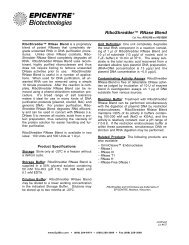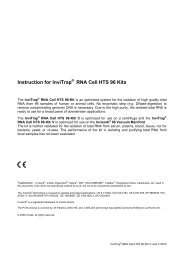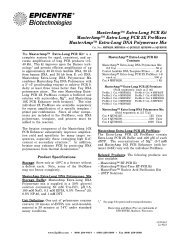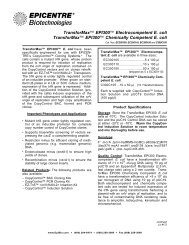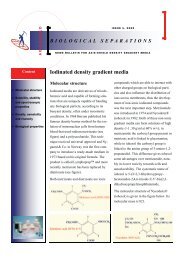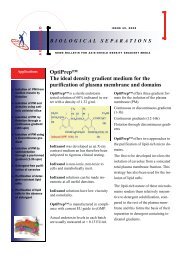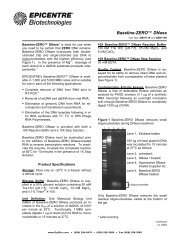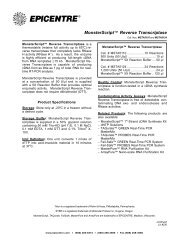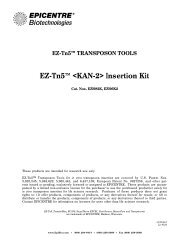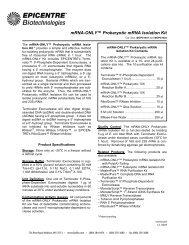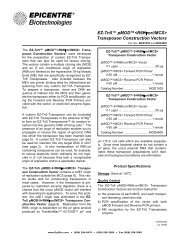Instruction for the Invisorb Spin Cell Mini Kit
Instruction for the Invisorb Spin Cell Mini Kit
Instruction for the Invisorb Spin Cell Mini Kit
- No tags were found...
Create successful ePaper yourself
Turn your PDF publications into a flip-book with our unique Google optimized e-Paper software.
<strong>Instruction</strong> <strong>for</strong> <strong>the</strong> <strong>Invisorb</strong> ® <strong>Spin</strong> <strong>Cell</strong> <strong>Mini</strong> <strong>Kit</strong><strong>for</strong> extrations of genomic DNA from cell culture, swabs, sera, plasmaThe <strong>Invisorb</strong> ® <strong>Spin</strong> <strong>Cell</strong> <strong>Mini</strong> <strong>Kit</strong> is <strong>the</strong> ideal tool, using <strong>the</strong> <strong>Invisorb</strong> ® technology <strong>for</strong> a fast, efficientand simple manual isolation and purification of genomic DNA from cultured cells (24 or 96 wellplates), serum, human and animal lavage, fresh or frozen plasma, bone marrow and urine. Thepurified DNA can be used <strong>for</strong> in-vitro diagnostic analysis.The kit is nei<strong>the</strong>r validated <strong>for</strong> <strong>the</strong> isolation of cells from tissue, blood, or stool sample, nor frombacteria, fungi, parasites or <strong>the</strong> purification of total RNA.The application of <strong>the</strong> kit <strong>for</strong> isolation and purification of viral DNA has not been evaluated.Trademarks: : <strong>Invisorb</strong> ® , Invitek. Registered marks, trademarks, etc. used in this document, even when not specificallymarked as such, are not to be considered unprotected by law.The <strong>Invisorb</strong> ® technology is covered by patents and patent applications: US 6,110363, US 6,043,354, US 6,037,465, EP0880535, WO 9728171, WO 9534569, EP 0765335, DE 19506887, DE 10041825.2, WO 0034463.<strong>Invisorb</strong> ® is a registered trademark of Invitek GmbH.The PCR process is covered by US Patents 4,683,195, and 4,683,202 and <strong>for</strong>eign equivalents owned by Hoffmann-LaRoche AG.© 2009 Invitek, all rights reserved.1<strong>Invisorb</strong> ® <strong>Spin</strong> <strong>Cell</strong> <strong>Mini</strong> <strong>Kit</strong> 032010
Contents<strong>Kit</strong> contents of <strong>the</strong> <strong>Invisorb</strong> ® <strong>Spin</strong> <strong>Cell</strong> <strong>Mini</strong> <strong>Kit</strong> ....................................................................... 3Symbols ...................................................................................................................................... 4Storage........................................................................................................................................ 4Quality control............................................................................................................................ 4Intended use ............................................................................................................................... 5Product use limitation................................................................................................................ 5Safety in<strong>for</strong>mation...................................................................................................................... 6Product characteristics of <strong>the</strong> <strong>Invisorb</strong> ® <strong>Spin</strong> <strong>Cell</strong> <strong>Mini</strong> <strong>Kit</strong>..................................................... 7Principle and procedure ............................................................................................................ 7Sampling and storage of starting material............................................................................... 7Procedure............................................................................................................................... 8Yield and quality of genomic DNA .......................................................................................... 8Important notes....................................................................................................................... 9Important points be<strong>for</strong>e starting a protocol.............................................................................. 9Preparing reagents and buffers .............................................................................................. 9Reagents and equipment to be supplied by user .................................................................. 10Important indications 10Scheme of <strong>the</strong> <strong>Invisorb</strong> ® <strong>Spin</strong> <strong>Cell</strong> <strong>Mini</strong> <strong>Kit</strong>: .......................................................................... 11Protocol 1: DNA isolation from cell culture (24-Well-Plates; max. 2x10 6 cells ....................... 12Protocol 2: DNA isolation from cell culture (96-Well-Plates)................................................. 13Protocol 3: DNA isolation of DNA from swab material (buccal swab; vaginal swab).............. 14Protocol 4: DNA isolation from Serum or Plasma (max. 100Al)............................................ 14Troubleshooting....................................................................................................................... 15Appendix................................................................................................................................... 16General notes on handling DNA ........................................................................................... 16Ordering in<strong>for</strong>mation................................................................................................................ 17Invitek distributors ................................................................................................................... 182<strong>Invisorb</strong> ® <strong>Spin</strong> <strong>Cell</strong> <strong>Mini</strong> <strong>Kit</strong> 032010
<strong>Kit</strong> contents of <strong>the</strong> <strong>Invisorb</strong> ® <strong>Cell</strong> <strong>Mini</strong> <strong>Kit</strong>Store all o<strong>the</strong>r kit components at room temperature (RT)!3 DNAextractions10 DNAextractions50 DNAextractions250 DNAextractionsCatalogue number 1033100100 1033100900 1033100200 1033100300Lysis Buffer D 5 ml 10 ml 30 ml125 mlBinding Buffer HL 2 ml 2 x 2 ml 15 ml 60 mlCarrier Suspension B 100 Al 150 Al 600 Al 2 x 1.3 mlWash Buffer15 ml(ready to use)15 ml(ready to use)18 ml(final volume 60 ml)2 x 45 ml(final volume 2 x 150 ml)Elution Buffer D 2 ml 2 x 2 ml 15 ml 60 mlRTA <strong>Spin</strong> Filter Set 3 10 50 2501.5 ml Receiver Tubes 3 10 50 250Manual 1 1 1 1Initial stepsWarmingwaterbath or<strong>the</strong>rmomixer to70°C and heat <strong>the</strong>Elution Buffer Dto <strong>the</strong> sametemperature.Warmingwaterbath or<strong>the</strong>rmomixer to70°C and heat <strong>the</strong>Elution Buffer Dto <strong>the</strong> sametemperature.Add 42 ml of 96-100% Ethanol to <strong>the</strong>bottle Wash Bufferand mix thoroughly.Store <strong>the</strong> WashBuffer always withfirmly closed cap.Storage at roomtemperature!Add 105 ml of 96-100%Ethanol to each bottleWash Buffer and mixthoroughly.Store <strong>the</strong> Wash Bufferalways with firmly closedcap.Storage at roomtemperature!Warming waterbathor <strong>the</strong>rmomixer to70°C and heat <strong>the</strong>Elution Buffer D to<strong>the</strong> sametemperature.Warming waterbath or<strong>the</strong>rmomixer to 70°Cand heat <strong>the</strong> ElutionBuffer D to <strong>the</strong> sametemperature.3<strong>Invisorb</strong> ® <strong>Spin</strong> <strong>Cell</strong> <strong>Mini</strong> <strong>Kit</strong> 032010
Symbolslot numbercatalog numberdate of manufactureexpiry dateconsult operating instructionstemperature limitationdo not reusemanufacturerStorage conditionsAll buffers and kit components of <strong>the</strong> <strong>Invisorb</strong> ® <strong>Spin</strong> <strong>Cell</strong> <strong>Mini</strong> <strong>Kit</strong> should be stored at roomtemperature (RT) and are stable <strong>for</strong> 12 months under <strong>the</strong>se conditions.Room temperature (RT) is defined as range from 15 - 30°C.Wash Buffer charged with ethanol should be appropriately sealed and stored at roomtemperature.If <strong>the</strong>re are any precipitates within <strong>the</strong> provided solutions dissolve <strong>the</strong>se precipitates by carefullywarming up to room temperature (up to 30°C).Quality controlInvitek guarantees <strong>the</strong> correct function of <strong>the</strong> <strong>Invisorb</strong> ® <strong>Spin</strong> <strong>Cell</strong> <strong>Mini</strong> <strong>Kit</strong> <strong>for</strong> applications asdescribed in <strong>the</strong> manual. In accordance with Invitek’s certified Quality Management System allcomponents of <strong>the</strong> <strong>Invisorb</strong> ® <strong>Spin</strong> <strong>Cell</strong> <strong>Mini</strong> <strong>Kit</strong> were tested against predetermined specificationsto ensure consistent product quality.If you have any questions or problems regarding any aspects of <strong>Invisorb</strong> ® <strong>Spin</strong> <strong>Cell</strong> <strong>Mini</strong> <strong>Kit</strong> oro<strong>the</strong>r Invitek products, please do not hesitate to contact us.For technical support or fur<strong>the</strong>r in<strong>for</strong>mation please contact:from Germany +49-(0)30-9489-2901/ 2910from abroad +49-(0)30-9489-2907or contact your local distributor (see page 18).4<strong>Invisorb</strong> ® <strong>Spin</strong> <strong>Cell</strong> <strong>Mini</strong> <strong>Kit</strong> 032010
Intended useThe <strong>Invisorb</strong> ® <strong>Spin</strong> <strong>Cell</strong> <strong>Mini</strong> <strong>Kit</strong>, is <strong>the</strong> ideal tool <strong>for</strong> a fast and convenient manual isolationand purification of genomic DNA from cultured cells (24 or 96 well plates), serum, human andanimal lavage, fresh or frozen plasma, bone marrow and urine. For reproducible and highyields an appropriate sample storage is essential. The purified DNA can be used <strong>for</strong> in-vitrodiagnostic analysis.The protocol <strong>for</strong> <strong>the</strong> isolation and all buffers are optimized <strong>for</strong> a high yield as well as a high purity.All hands on steps are reduced to a minimum.The product is intended <strong>for</strong> use by professional users such as technicians, physicians, andbiologists trained in molecular biological techniques. It is designed to be used with anydownstream application employing enzymatic amplification or o<strong>the</strong>r enzymatic modification ofDNA followed by signal detection or amplification. Any diagnostic results generated using <strong>the</strong>sample preparation procedure in conjunction with any downstream diagnostic assay should beinterpreted with regard to o<strong>the</strong>r clinical or laboratory findings.To minimize irregularities in diagnostic results, adequate controls <strong>for</strong> downstream applicationsshould be used.Product use limitationThe kit is not validated <strong>for</strong> <strong>the</strong> isolation of genomic DNA bacteria, fungi, parasites, orpurification of RNA.The application of <strong>the</strong> kit <strong>for</strong> isolation and purification of viral DNA has not been evaluated.When changing <strong>the</strong> starting material or <strong>the</strong> flow trace, no guarantee in operability is issued.The user is responsible to validate <strong>the</strong> per<strong>for</strong>mance of <strong>the</strong> Invitek kits <strong>for</strong> any particular use, since<strong>the</strong> per<strong>for</strong>mance characteristics of our kits have not been validated <strong>for</strong> any specific application.Invitek kits may be used in clinical diagnostic laboratory systems after <strong>the</strong> laboratory has validated<strong>the</strong> complete diagnostic system as required by CLIA’ 88 regulations in <strong>the</strong> U.S. or equivalents ino<strong>the</strong>r countries.All products sold by Invitek are subjected to extensive quality control procedures according to ENISO 9001 : 2000 and EN ISO 13485 : 2003, and are warranted to per<strong>for</strong>m as described whenused correctly. Any problems should be reported immediately.The chemicals and plastic parts are <strong>for</strong> laboratory use only, <strong>the</strong>y have to be stored in <strong>the</strong>laboratory and must not used <strong>for</strong> o<strong>the</strong>r purposes than intended.The kit contents are unfit <strong>for</strong> consumption.5<strong>Invisorb</strong> ® <strong>Spin</strong> <strong>Cell</strong> <strong>Mini</strong> <strong>Kit</strong> 032010
Safety in<strong>for</strong>mationWhen working with chemicals, always wear a suitable lab coat, disposable gloves, and protectivegoggles. Heed <strong>the</strong> legal requirements <strong>for</strong> working with biological material!For more in<strong>for</strong>mation, please consult <strong>the</strong> appropriate material safety data sheets (MSDS). Theseare available in convenient and compact PDF <strong>for</strong>mat online at www.invitek.de under each Invitekkit and kit component.If <strong>the</strong> buffer bottles are damaged or leaking, wear gloves and protective goggles when discarding<strong>the</strong> bottles in order to avoid any injuries.Invitek has not tested <strong>the</strong> liquid waste generated by <strong>the</strong> <strong>Invisorb</strong> ® <strong>Spin</strong> <strong>Cell</strong> <strong>Mini</strong> procedures <strong>for</strong>residual infectious materials. Contamination of <strong>the</strong> liquid waste with residual infectious materials ishighly unlikely, but cannot be excluded completely. There<strong>for</strong>e, liquid waste must be consideredinfectious and be handled and discarded according to local safety regulations.Below European Community risk and safety phrases <strong>for</strong> <strong>the</strong> components of <strong>the</strong> <strong>Invisorb</strong> ® <strong>Spin</strong> <strong>Cell</strong><strong>Mini</strong> <strong>Kit</strong> to which <strong>the</strong>y apply, are listed.Lysis Buffer D:Binding Buffer HL:Xn contains: Guanidinthiocyanate Xi , Fharmfulhighly flammable, irritant(R32, S2, S50)R11, 36, 67, S2, 7,16, S24/25/26R:11:highly flammableR36: irritating to eyesR67: vapours may cause drowsiness and dizzinessS2: keep out of <strong>the</strong> reach of childrenS7: keep container tightly closedS16: keep away from sources of ignition - No smokingS22: do not breath dustS24: avoid contact with skinS25: avoid contact with eyesS26: in case of contact with eyes, rinse immediately with plenty of water and seek medical adviceS50do not mix with strong acids or lyses, nonferrous heavy metals and <strong>the</strong>ir salts.Emergency medical in<strong>for</strong>mation in english and german language can be obtained 24 hours a dayfrom:Poison In<strong>for</strong>mation Center Freiburg, Germany: Tel.: ++49 761-192406<strong>Invisorb</strong> ® <strong>Spin</strong> <strong>Cell</strong> <strong>Mini</strong> <strong>Kit</strong> 032010
Product characteristic of <strong>the</strong> <strong>Invisorb</strong> ® <strong>Spin</strong> <strong>Cell</strong> <strong>Kit</strong>Starting materialYieldTime <strong>for</strong>preparationRatio- max. 5 x 10 7 cells(2 ml of overnight culture )- cell cultures(max. 2 x 10 6 cells),- swabs, serum or plasmaup to 10 Ag of genomicDNA depends onamount and type ofstarting materialabout 20 - 30 min A 260 : A 2801.7 – 2.0The <strong>Invisorb</strong> ® <strong>Spin</strong> <strong>Cell</strong> <strong>Mini</strong> <strong>Kit</strong> has been designed <strong>for</strong> fast and easy purification of highmolecular-weightgenomic and mitochondrial DNA from cell culture, swabs, serum andplasma.After cell wall lysis <strong>the</strong> starting material will be directly mixed with an optimized Lysis BufferD including reagents inactivating intracellular DNases and also DNases found elsewhere in<strong>the</strong> environment. DNA is on <strong>the</strong> surface of a filter as contaminants pass through. Remainingcontaminants and enzyme inhibitors are removed in an efficient wash steps and DNA is <strong>the</strong>neluted in water or buffer, ready <strong>for</strong> use.The <strong>Invisorb</strong> ® <strong>Spin</strong> <strong>Cell</strong> <strong>Mini</strong> <strong>Kit</strong> avoids <strong>the</strong> application of toxic cancerogeneous organicsolvents as well as ethanol precipitation. The convenient, purification procedure removescontaminants and enzyme inhibitors such as proteins and divalent cations, and purified DNAis ready <strong>for</strong> immediate use in sensitive downstream applications like, or <strong>for</strong> archiving.LLLLLPCR applicationsdigestion with restriction enzymesSou<strong>the</strong>rn HybridizationRFLP analysisHLA typing (DQA; DQB).Principle and procedureThe <strong>Invisorb</strong> ® <strong>Spin</strong> <strong>Cell</strong> <strong>Mini</strong> <strong>Kit</strong> procedure comprises following steps:1. lysis of sample material2. binding <strong>the</strong> genomic DNA on a <strong>Spin</strong> Filter3. washing <strong>the</strong> <strong>Spin</strong> Filter and elimination of ethanol4. elution of genomic DNAThis manual contains 4 protocols, according to <strong>the</strong> different requirements of <strong>the</strong> startingmaterials.Sampling and storage of starting material:<strong>Cell</strong> cultures:The yield and quality of DNA may depend on factors such host strain, inoculation, antibiotic,and type of culture medium. The cells will be pelleted after cultivation. Best results areobtained with fresh material or material that has been immediately frozen and stored at –20°C or –80°C. Repeated freezing and thawing of stored samples should be avoided, sincethis leads to reduced DNA size.7<strong>Invisorb</strong> ® <strong>Spin</strong> <strong>Cell</strong> <strong>Mini</strong> <strong>Kit</strong> 032010
Buccal swabs:To collect a sample, scrape <strong>the</strong> swab firmly against inside of each cheek 6 times. Air-dry <strong>the</strong>swab <strong>for</strong> at least 2h after collection or use <strong>the</strong>m fresh prepared. Ensure that <strong>the</strong> personproviding <strong>the</strong> sample has not consumed any food or drink in <strong>the</strong> 30 min prior to samplecollection. Best results are obtained if <strong>the</strong> swab stays in <strong>the</strong> lysis solution during lysisprocedure. Use of poor quality starting material influences yield of purified DNA. This protocolis recommended <strong>for</strong> every common swab, like e.g. <strong>the</strong> following swab types: C:E:P: (OmniSwab from Whatman), cotton swab, Superswabs, Copan-Swab or DRACON tip fromHardwood Products company, <strong>Cell</strong>Projects or Hain Diagnostika)<strong>Cell</strong>s grown in suspension:<strong>Spin</strong> up to 1 x 10 7 cells <strong>for</strong> 5 min at 300 x g (1.500 rpm* ). Discard supernatant and remove allmedia completely, taking care not to disturb <strong>the</strong> cell pellet. At this point cells may be frozen (at -20°C or - 80°C) <strong>for</strong> future use or may be used immediately.<strong>Cell</strong>s grown in a monolayer:Aspirate <strong>the</strong> media completely from <strong>the</strong> cells and continue immediately with <strong>the</strong> lysis step.Alternatively cells can be detached by trypsination (cultivation in larger culture vessels, likedishes > 35 mm, flasks > 12.5 cm 2 ). Transfer cells to a 50 ml reaction tube, pellet bycentrifugation at 300 x g (1.500 rpm* ) <strong>for</strong> 5 min and aspirate supernatant completely.ProcedureLysisSamples are lysed at elevated temperatures. Lysis is per<strong>for</strong>med in <strong>the</strong> presence of LysisBuffer D.Binding genomic DNABy adding Binding Buffer HL to <strong>the</strong> lysate, optimal binding conditions will be adjusted.All lysate is applied to a spin filterRemoving residual contaminationsContaminants are efficiently washed away using Wash Buffer, while <strong>the</strong> genomic DNAremains bound to <strong>the</strong> spin filter.ElutionGenomic DNA is eluted from <strong>the</strong> spin filter using 30 - 200 Al Elution Buffer D. The eluted DNAis ready <strong>for</strong> use in different downstream applications. Eluted DNA stored at 4 – 8°C is stable <strong>for</strong>2 months or <strong>for</strong> more than 5 years if stored at -20°C.Yield and quality of genomic DNAThe amount of purified DNA using <strong>the</strong> <strong>Invisorb</strong> ® <strong>Spin</strong> <strong>Cell</strong> <strong>Mini</strong> <strong>Kit</strong> procedure, depends on <strong>the</strong>strain, <strong>the</strong> number of cells in <strong>the</strong> sample, <strong>the</strong> sample source, transport conditions, storage, andage of <strong>the</strong> sample.Yield and quality of isolated genomic DNA is suitable <strong>for</strong> any molecular-diagnostic detectionsystem. The diagnostic tests should be per<strong>for</strong>med according to manufacturers’ specifications.8<strong>Invisorb</strong> ® <strong>Spin</strong> <strong>Cell</strong> <strong>Mini</strong> <strong>Kit</strong> 032010
Important notesImportant points be<strong>for</strong>e starting a protocolAfter receiving <strong>the</strong> kit, check <strong>the</strong> kit components <strong>for</strong> damage. If buffer bottles are damaged,contact <strong>the</strong> Invitek Technical Services or your local distributor. In case of liquid spillage, refer to“Safety in<strong>for</strong>mation” (page 6). Do not use damaged kit components, since <strong>the</strong>ir use may lead topoor kit per<strong>for</strong>mance.LLLLLLLLalways change pipet tips between liquid transfer. To avoid cross-contamination, werecommend <strong>the</strong> use of aerosol-barrier pipet tipsall centrifugation steps are carried out at room temperaturewhen working with chemicals, always wear a suitable lab coat, disposable gloves, andprotective gogglesdiscard gloves if <strong>the</strong>y become contaminateddo not combine components of different kits unless <strong>the</strong> lot numbers are identicalavoid microbial contamination of <strong>the</strong> kit reagentsto minimize <strong>the</strong> risk of infections from potentially infectious material, we recommendworking under laminar air-flow until <strong>the</strong> samples are lysedthis kit should only be used by trained personalPreparing reagents and buffers1. adjust <strong>the</strong> <strong>the</strong>rmo mixer to 37°C and 70°C.2. warm up <strong>the</strong> needed amount of Elution Buffer D to 70°C(100 - 200 Al Elution Buffer D are needed per sample).3. label <strong>the</strong> needed amount of <strong>Spin</strong> Filter4. label <strong>the</strong> needed amount of 1.5 ml Receiver Tubes5. add <strong>the</strong> needed amount of ethanol to <strong>the</strong> Wash Buffer3 DNA or 10 extractions:Wash Buffer is ready to use!50 DNA extractions:Add 42 ml of 96 - 100 % ethanol to Wash Buffer, mix thoroughly and always keep <strong>the</strong> bottlefirmly closed!250 DNA extractions:Add 105 ml of 96 - 100 % ethanol to Wash Buffer, mix thoroughly and always keep <strong>the</strong> bottlefirmly closed!9<strong>Invisorb</strong> ® <strong>Spin</strong> <strong>Cell</strong> <strong>Mini</strong> <strong>Kit</strong> 032010
Reagents and equipment to be supplied by userWhen working with chemicals, always wear a suitable lab coat, disposable gloves, and protectivegoggles. For more in<strong>for</strong>mation, please consult <strong>the</strong> appropriate material safety data sheets(MSDS). These are available online in convenient and compact PDF <strong>for</strong>mat at www.invitek.deunder each Invitek kit and kit component.LLLLLLLLmicro centrifuge<strong>the</strong>rmo mixer (<strong>for</strong> 70°C)measuring cylinder (250 ml)disposable glovespipette and pipette tipsvortexerreaction tubes (1.5 ml or 2.0 ml)dd H 2 O96 - 100 % ethanolImportant indications1. Process only as much samples as <strong>the</strong> micro centrifuge allows to process.2. Buffers should be thoroughly mixed and should have room temperature3. The elution can be done by using lower amount of Elution Buffer D. This may result in ahigher concentration of DNA. But pay attention that minimum volume <strong>for</strong> elution is 50 Al,but this will reduce <strong>the</strong> yield. Elution volume between 2 x 50 Al up to 200 Al will realizecomparable results.4. The eluted DNA volume can be lower than <strong>the</strong> added Elution Buffer D volume.Elution Buffer D should be preheated to 56 °C.5. The Elution Buffer D doesn’t contain EDTA.6. The yield can be increased, if <strong>the</strong> incubation time with preheated Elution Buffer D will beprolonged.10<strong>Invisorb</strong> ® <strong>Spin</strong> <strong>Cell</strong> <strong>Mini</strong> <strong>Kit</strong> 032010
Scheme of <strong>the</strong> <strong>Invisorb</strong> ® <strong>Spin</strong> <strong>Cell</strong> <strong>Kit</strong>Please read protocols prior <strong>the</strong> start of <strong>the</strong> preparation carefully--------------------------------------------------------------------------------------remove medium and wash cells twice with 1 x PBS (not included in <strong>the</strong> kit)add 500 Al Lysis Buffer D pipet up and down several times and incubateat room temperature <strong>for</strong> 3 min.transfer <strong>the</strong> whole cell lysis suspension into a 1.5 ml or 2.0 ml reaction tube.add 10 Al Carrier Suspension B and 200 Al Binding Buffer HLmix briefly and transfer <strong>the</strong> suspension directly onto <strong>the</strong> RTA <strong>Spin</strong> Filter.incubate <strong>for</strong> 2 mincentrifuge <strong>for</strong> 3 min at 13.000 x g (12.000 rpm)discard <strong>the</strong> flow-through and reuse <strong>the</strong> RTA Receiver Tube.Add 550 Al Wash Buffer and centrifuge <strong>for</strong> 1 min at 13.400 x g (12.000 rpm).Discard <strong>the</strong> flow-throughrepeat step once again.centrifuge <strong>for</strong> 3 min at 13.400 x g (12.000 rpm) toremove <strong>the</strong> residual ethanol.transfer <strong>the</strong> RTA <strong>Spin</strong> Filter into a new 1.5 ml Receiver Tube.genomic DNAadd 200 Al of Elution Buffer D prewar med to 70°C directly onto <strong>the</strong>membrane of <strong>the</strong> RTA <strong>Spin</strong> Filter.incubate <strong>for</strong> 2 min.centrifuge at 9.300 x g (10.000 rpm) <strong>for</strong> 2 min.discard <strong>the</strong> <strong>Spin</strong> Filterclose <strong>the</strong> 1.5 ml Receiver Tube and store <strong>the</strong> eluted DNA sample at 4 °C11<strong>Invisorb</strong> ® <strong>Spin</strong> <strong>Cell</strong> <strong>Mini</strong> <strong>Kit</strong> 032010
Protocol 1: DNA isolation from cell culture (24-Well-Plates;max. 2x10 6 cells)Important: Incubate <strong>the</strong> Elution Buffer D at 70°C1. Remove medium and wash cells twice with 1 x PBS (not included in <strong>the</strong> kit).2. Add 500 Al Lysis Buffer D per well, pipet up and down several times and incubate at roomtemperature <strong>for</strong> 3 min.Note:Should Lysis Buffer D contain any precipitates incubate it in a 50°C waterbath <strong>for</strong> a short time!3. Transfer <strong>the</strong> whole cell lysis suspension into a 1.5 ml or 2.0 ml microcentrifuge tube.Note:Vortex <strong>the</strong> Carrier Suspension B thoroughly prior to use.4. Addition of 10 Al Carrier Suspension B and 200 Al Binding Buffer HL, mix briefly andtransfer <strong>the</strong> suspension directly onto <strong>the</strong> RTA <strong>Spin</strong> Filter. Incubation <strong>for</strong> 2 min.5. Centrifugation <strong>for</strong> 3 min at 13.400 x g (12.000 rpm). Discard <strong>the</strong> flow-through and reuse <strong>the</strong>RTA Receiver Tube.6. Add 550 Al Wash Buffer and centrifuge <strong>for</strong> 1 min at 13.400 x g (12.000 rpm). Discard <strong>the</strong>flow-through.7. Repeat step 6 once again. Afterwards centrifuge <strong>for</strong> 3 min at 13.400 x g (12.000 rpm) toremove <strong>the</strong> residual ethanol.8. Transfer <strong>the</strong> RTA <strong>Spin</strong> Filter into a new 1.5 ml Receiver Tube. Add 200 Al of ElutionBuffer D or Tris buffered ddH 2 0 (pH 8.5 - 9.0) prewarmed to 70°C directly onto <strong>the</strong>membrane of <strong>the</strong> RTA <strong>Spin</strong> Filter.Incubation <strong>for</strong> 2 min. Centrifugation at 9.300 x g (10.000 rpm) <strong>for</strong> 2 min.Discard <strong>the</strong> RTA <strong>Spin</strong> Filter.12<strong>Invisorb</strong> ® <strong>Spin</strong> <strong>Cell</strong> <strong>Mini</strong> <strong>Kit</strong> 032010
Protocol 2: DNA isolation from cell culture (96-Well-Plates)Important: Incubate <strong>the</strong> Elution Buffer D at 70°C1. Remove medium and wash cells twice with 1 x PBS (not included in <strong>the</strong> kit).2. Add 350 Al Lysis Buffer D per well, pipet up and down several times and incubate at roomtemperature <strong>for</strong> 5 min.Note:Should Lysis Buffer D contain any precipitates incubate it in a 50°C waterbath <strong>for</strong> a short time!3. Transfer <strong>the</strong> whole cell lysis suspension into a 1.5 ml or 2.0 ml microcentrifuge tube.Note:Vortex <strong>the</strong> Carrier Suspension B thoroughly prior to use.4. Addition of 10 Al Carrier Suspension B, 150 Al Lysis Buffer D and 200 Al Binding BufferHL, mix briefly and transfer <strong>the</strong> suspension directly onto <strong>the</strong> RTA <strong>Spin</strong> Filter.Incubation <strong>for</strong> 2 min.5. Centrifugation <strong>for</strong> 3 min at 13.400 x g (12.000 rpm). Discard <strong>the</strong> flow-through and reuse <strong>the</strong>RTA Receiver Tube.6. Add 550 Al Wash Buffer and centrifuge <strong>for</strong> 1 min at 13.400 x g (12.000 rpm). Discard <strong>the</strong>flow-through.7. Repeat step 6 once again. Afterwards centrifuge <strong>for</strong> 3 min at 13.400 x g (12.000 rpm) toremove <strong>the</strong> residual ethanol.8. Transfer <strong>the</strong> RTA <strong>Spin</strong> Filter into a new 1.5 ml Receiver Tube. Add 100 Al of ElutionBuffer D or Tris buffered ddH 2 0 (pH 8.5 - 9.0) prewarmed to 70°C directly onto <strong>the</strong>membrane of <strong>the</strong> RTA <strong>Spin</strong> Filter. Incubation <strong>for</strong> 2 min. Centrifugation at 9.300 x g(10.000 rpm) <strong>for</strong> 2 min. Discard <strong>the</strong> RTA <strong>Spin</strong> Filter.13<strong>Invisorb</strong> ® <strong>Spin</strong> <strong>Cell</strong> <strong>Mini</strong> <strong>Kit</strong> 032010
Protocol 3: DNA isolation of DNA from Swab material(Buccal Swab; Vaginal Swab)Important: Incubate <strong>the</strong> Elution Buffer D at 70°C1. Incubation of <strong>the</strong> swab in a 1.5 or 2.0 ml microfuge tube with 500 Al Lysis Buffer D <strong>for</strong> 5 min.Grind <strong>the</strong> swab on <strong>the</strong> wall of <strong>the</strong> tube carefully and remove <strong>the</strong> swab.Note: Should Lysis Buffer D contain any precipitates incubate it in a 50°C waterbath <strong>for</strong> a short time!Note:Vortex <strong>the</strong> Carrier Suspension B thoroughly prior to use.2. Addition of 10 Al Carrier Suspension B and 200 Al of Binding Buffer HL, mix briefly andtransfer <strong>the</strong> suspension directly onto <strong>the</strong> RTA <strong>Spin</strong> Filter. Incubation <strong>for</strong> 2 min.3. Centrifugation <strong>for</strong> 3 min at 13.400 x g (12.000 rpm). Discard <strong>the</strong> flow-through and reuse <strong>the</strong>RTA Receiver Tube.4. Addition of 550 Al Wash Buffer and centrifugation <strong>for</strong> 1 min at 13.400 x g (12.000 rpm).Discard <strong>the</strong> flow-through.5. Repeat step 4 once again. Afterwards centrifuge <strong>for</strong> 3 min at 13.400 x g (12.000 rpm) toremove <strong>the</strong> residual ethanol.6. Transfer <strong>the</strong> RTA <strong>Spin</strong> Filter into a new 1.5 ml Receiver Tube. Add 100 Al of ElutionBuffer D or Tris buffered ddH 2 0 (pH 8.5 - 9.0) prewarmed to 70°C directly onto <strong>the</strong>membrane of <strong>the</strong> RTA <strong>Spin</strong> Filter. Incubation <strong>for</strong> 2 min. Centrifugation at 9.300 x g(10.000 rpm) <strong>for</strong> 2 min.Discard <strong>the</strong> RTA <strong>Spin</strong> Filter.Protocol 4: DNA isolation from Serum or Plasma (max. 100Fl)Important: Incubate <strong>the</strong> Elution Buffer D at 70°C1. Addition of 500 Al Lysis Buffer D to <strong>the</strong> Serum or Plasma sample (max. 100 Al) andincubation <strong>for</strong> 10 min (continuous shaking increases <strong>the</strong> lysis efficiency!).Note:Note:Should Lysis Buffer D contain any precipitates incubate it in a 50°C waterbath <strong>for</strong> a shorttime!Vortex <strong>the</strong> Carrier Suspension B thoroughly prior to use.2. Addition of 10 Al Carrier Suspension B and 200 Al Binding Buffer HL, mix briefly andtransfer <strong>the</strong> suspension directly onto <strong>the</strong> RTA <strong>Spin</strong> Filter. Incubation <strong>for</strong> 2 min.3. Centrifugation <strong>for</strong> 3 min at 13.400 x g (12.000 rpm). Discard <strong>the</strong> flow-through and reuse <strong>the</strong>RTA Receiver Tube.4. Addition of 550 Al Wash Buffer and centrifugation <strong>for</strong> 1 min at 13.400 x g (12.000 rpm).Discard <strong>the</strong> flow-through.5. Repeat step 4 once again. Afterwards centrifuge <strong>for</strong> 3 min at 13.400 x g (12.000 rpm) toremove <strong>the</strong> residual ethanol.6. Transfer <strong>the</strong> RTA <strong>Spin</strong> Filter into a new 1.5 ml Receiver Tube. Add 100 Al of ElutionBuffer D or Tris buffered ddH 2 0 (pH 8.5 - 9.0) prewarmed to 70°C directly onto <strong>the</strong>membrane of <strong>the</strong> RTA <strong>Spin</strong> Filter. IIncubation <strong>for</strong> 2 min. Centrifugation at 9.300 x g(10.000 rpm) <strong>for</strong> 2 min. Discard <strong>the</strong> RTA <strong>Spin</strong> Filter.14<strong>Invisorb</strong> ® <strong>Spin</strong> <strong>Cell</strong> <strong>Mini</strong> <strong>Kit</strong> 032010
TroubleshootingProblem Cause Comments and suggestionslow yield ofDNAincomplete lysis of startingmaterialimproper storage of startingmaterialpoor DNA binding of <strong>the</strong> DNAsubstantial loss of boundDNA in <strong>the</strong> washing step dueto low ethanol concentrationin <strong>the</strong> Wash Bufferpoor elution of <strong>the</strong> DNAincrease <strong>the</strong> lysis timestore <strong>the</strong> samples carefully.mix <strong>the</strong> sample with <strong>the</strong> Binding Buffer HLcarefully.prepare <strong>the</strong> Wash Buffer exactly as describedin <strong>the</strong> manualstorge of Wash Buffer with firmly fixed capcarry out a second elutionprewarm <strong>the</strong> Elution medium to 70°Cclotting of <strong>the</strong>membranestarting volume to highcentrifugation speed to slowreduce starting volumeincrease <strong>the</strong> Centrifugation speedincrease <strong>the</strong> Centrifugation timebad results inPCRcontamination of final DNAsolution with residual saltscontamination of final DNAsolution by ethanolwashing of <strong>the</strong> <strong>Spin</strong> Filter as described inmanualremove <strong>the</strong> ethanol careful (test <strong>the</strong> smell)poor cleavage byrestrictionendonucleasesEDTA in <strong>the</strong> Elution Buffer Delution of DNA in Tris buffered dd H 2 O(especially when using enzymes sensitive toEDTA).15<strong>Invisorb</strong> ® <strong>Spin</strong> <strong>Cell</strong> <strong>Mini</strong> <strong>Kit</strong> 032010
AppendixGeneral notes on handling DNANature of DNAThe length and delicate physical nature of DNA requires careful handling to avoid damagedue to shearing and enzymatic degradation. O<strong>the</strong>r conditions that affect <strong>the</strong> integrity andstability of DNA include acidic and alkaline environments, high temperature, and UVirradiation. Careful isolation and handling of high molecular weight DNA is necessary toensure compatibility with various downstream applications. Damaged DNA could per<strong>for</strong>mpoorly in applications such as genomic Sou<strong>the</strong>rn blotting, and long-template PCR.Storage of DNAA working stock of DNA can be stored at 2 – 4RC <strong>for</strong> several weeks. For long term storageDNA should be stored at -20RC, but storing at – 20°C can cause shearing, particularly if <strong>the</strong>DNA is exposed to repeated freeze-thaw cycles.Note that <strong>the</strong> solution in which <strong>the</strong> nucleic acid is eluted in will affect it’s stability duringstorage. Pure water lacks buffering capacity and an acidic pH may lead to acid hydrolysis.Tris or Tris-EDTA buffer contains sufficient buffering capacity to prevent acid hydrolysis.Drying, dissolving and pipetting DNAAvoid over drying genomic DNA after ethanol precipitation. It is better to let it air dry than touse a vacuum, although vacuum drying can be used with caution.Avoid vigorous pipetting. Pipetting genomic DNA through small tip openings causes shearingor nicking. One way to decrease shearing of genomic DNA is to use special tips that havewide openings designed <strong>for</strong> pipetting genomic DNA.DNA YieldThe amount of purified DNA from <strong>the</strong> cells, depends on <strong>the</strong> DNA content of <strong>the</strong> sample,transport, storage, and age.16<strong>Invisorb</strong> ® <strong>Spin</strong> <strong>Cell</strong> <strong>Mini</strong> <strong>Kit</strong> 032010
Ordering in<strong>for</strong>mationProduct Package size Order-Nr.<strong>Invisorb</strong> ® <strong>Spin</strong> <strong>Cell</strong> <strong>Mini</strong> <strong>Kit</strong> 3 preparations 1033100100<strong>Invisorb</strong> ® <strong>Spin</strong> <strong>Cell</strong> <strong>Mini</strong> <strong>Kit</strong> 50 preparations 1033100200<strong>Invisorb</strong> ® <strong>Spin</strong> <strong>Cell</strong> <strong>Mini</strong> <strong>Kit</strong> 250 preparations 1033100300Single components <strong>for</strong> <strong>Invisorb</strong> ® <strong>Cell</strong> <strong>Mini</strong> <strong>Kit</strong>Lysis Buffer D 30 ml 1033101000Binding Buffer HL 10 ml 1033102300Carrier Suspension B 0.5 ml 1033107200Wash Buffer (add 42 ml) 18 ml 1033103200Elution Buffer D 15 ml 1033104000Related products<strong>Invisorb</strong> ® <strong>Spin</strong> Yeast DNA <strong>Mini</strong> <strong>Kit</strong> 3 preparations 1033120100<strong>Invisorb</strong> ® <strong>Spin</strong> Yeast DNA <strong>Mini</strong> <strong>Kit</strong> 50 preparations 1033120300<strong>Invisorb</strong> ® <strong>Spin</strong> Yeast DNA <strong>Mini</strong> <strong>Kit</strong> 250 preparations 1033120400<strong>Invisorb</strong> ® <strong>Spin</strong> Swab <strong>Kit</strong> 3 preparations 1035120100<strong>Invisorb</strong> ® <strong>Spin</strong> Swab <strong>Kit</strong> 50 preparations 1035120200<strong>Invisorb</strong> ® <strong>Spin</strong> Swab <strong>Kit</strong> 250 preparations 1035120300PSP ® SalivaGene DNA <strong>Kit</strong> 3 preparations 1035200100PSP ® SalivaGene DNA <strong>Kit</strong> 50 preparations 1035200200PSP ® SalivaGene DNA <strong>Kit</strong> 250 preparations 1035200300<strong>Invisorb</strong> ® <strong>Spin</strong> Tissue <strong>Mini</strong> <strong>Kit</strong> 3 preparations 1032100100<strong>Invisorb</strong> ® <strong>Spin</strong> Tissue <strong>Mini</strong> <strong>Kit</strong> 50 preparations 1032100200<strong>Invisorb</strong> ® <strong>Spin</strong> Tissue <strong>Mini</strong> <strong>Kit</strong> 250 preparations 1032100300<strong>Invisorb</strong> ® Tissue HTS 96 <strong>Kit</strong>/C 2 x 96 preparations 7032300200<strong>Invisorb</strong> ® Tissue HTS 96 <strong>Kit</strong>/C 4 x 96 preparations 7032300300<strong>Invisorb</strong> ® Tissue HTS 96 <strong>Kit</strong>/C 24 x 96 preparations 7032300400<strong>Invisorb</strong> ® DNA <strong>Cell</strong> HTS 96 <strong>Kit</strong>/C 2 x 96 preparations 7039400200<strong>Invisorb</strong> ® DNA <strong>Cell</strong> HTS 96 <strong>Kit</strong>/C 4 x 96 preparations 7039400300<strong>Invisorb</strong> ® DNA <strong>Cell</strong> HTS 96 <strong>Kit</strong>/C 24 x 96 preparations 7039400400InviMag ® Tissue DNA <strong>Kit</strong>/ KF96 1 x 96 preparations 7432300100InviMag ® Tissue DNA <strong>Kit</strong>/ KF96 5 x 96 preparations 7432300200InviMag ® Tissue DNA <strong>Kit</strong>/ KFmL 1 x 75 preparations 2432110100InviMag ® Tissue DNA <strong>Kit</strong>/ KFmL 5 x 75 preparations 243211010017<strong>Invisorb</strong> ® <strong>Spin</strong> <strong>Cell</strong> <strong>Mini</strong> <strong>Kit</strong> 032010
Invitek distributorsAustraliaMedica Pacifica Ltdbhoo@medica.co.nzwww.medica.co.nzFreephone: 1800 201 386Mobile: 021 633 820Phone: ++ 649 629 0823Fax: ++ 649 629 0542AustriaIBL Martinibl@ibl.or.atwww.ibl.or.atPhone:++ 43 02246-20 500Fax.:++ 43 02246-20 500 20BrazilUNISCIENCE DO BRASIL Ind. Com. Rep. Ltdasergio.joelsons@uniscience.comwww.uniscience.com.brPhone: ++ 55 (11) 3622-2328Fax ++ 55 (11) 3622-2333BelgiumWestburg b.v.info@westburg.nlwww.westburg.nlPhone:++ 31 33 4950094Fax.:++ 31 33 4951222CanadaESBE Scientificinfo@esbe.comwww.esbe.comPhone:++ 1 800-268-3477Fax: ++ 1-800-387-0476ChinaGene Tech (Shanghai) Co. Ltd6/F, Building 25, No 69 Guiqing Road,Cao He-jing High-Tech Park,Shanghai 200233P.R.ChinaTel: ++ 86-021-64957570Fax: ++ 86-021-64957610ChileAndes Importadora y Exportadora Ltdacristian.candia@andesimport.clwww.andesimport.clPhone:++ 56 - 2 – 6834510Fax: ++ 56 - 2 - 6834510Czech RepublicCHEMOS Cz, s.r.o.info@chemos.czwww.chemos.czPhone:++ 420 272 701 793Fax:++ 420 272 705 485Czech RepublicMERCI, s.r.o.Hviezdoslavova 55bjanecka@merci.czwww.merci.czPhone:++ 420 602 410 197DenmarkWestburg b.v.info@westburg.nlwww.westburg.nlPhone: ++ 45 48 76 06 93/ ++ 31 33 4950094Fax: ++ 45 30 62 33 34/ ++ 31 33 4951222EstoniaICOSAGEN ASNooruse 950411 Tartuinfo@icosagen.comwww.icosagen.comPhone:++ 372 737 7070FinlandWestburg b.v.info@westburg.nlwww.westburg.nlPhone: ++ 45 48 76 06 93/ ++ 31 33 4950094Phone: ++ 45 30 62 33 34 / + 31 33 4951222FranceLaboratoire EUROBIOadv@eurobio.frwww.eurobio.frPhone: ++ 33(0)1 60 92 21 83Fax.:++ 33(0) 1 69 07 95 34GreeceBioline Scientificdemagos@hol.grPhone:++ 3015226547 / ++ 3015249881Fax.:++ 30 1 5244744Hong KongB & R Technology Ltd.leo_law@bnr.com.hkPhone:++ 852 2547 8688Fax.:++ 852 2915 1522IcelandWestburg b.v.info@westburg.nlwww.westburg.nlPhone:++ 31 33 4950094Fax.:++ 31 33 4951222IndiaGenxBio Health Sciences Pvt. Ltd,.genxbio@gmail.comwww.genxbio.comPhone:++919216502501Fax.:++911-55607726IranAria Exirm.b@ariaexir.comwww.ariaexir.comPhone:++ 98 21 8872 1001Fax.: ++ 98 21 8872 1001IsraelGadot Laboratory Supply LTDayelet@gadot.comPhone:++ 972 -50-7744842Fax.:++972 -8-6900650ItalySPA Società Prodotti Antibioticiceroni@spaspa.itwww.spaspa.it/biospa.htmPhone:++ 39 02 8913 9542Fax.:++ 39 02 8912 0996JapanWako Pure Chemicals Industries, Ltd.satoh.yumiko@wako-chem.co.jpwww.wako-chem.co.jpPhone:++ 81-6-6203-374Fax.:++ 81-6-6229-129EgyptGenoLab co. <strong>for</strong> importing & tradinggeno_lab@hotmail.comPhone:++ 20 012 7307778Fax.:++ 20 02 670647018 <strong>Invisorb</strong> ® <strong>Spin</strong> <strong>Cell</strong> <strong>Mini</strong> <strong>Kit</strong> 032010
KoreaPhilekorea Technology Inc.www.philekorea.co.krPhone: ++ 82-42-862-9636Fax: ++ 82-42-862-9638LuxembourgWestburg b.v.info@westburg.nlwww.westburg.nlPhone:++ 31 33 4950094Fax.:++ 31 33 4951222Ne<strong>the</strong>rlandsWestburg b.v.info@westburg.nlwww.westburg.nlPhone:++ 31 33 4950094Fax.:++ 31 33 4951222New ZealandMedica Pacifica Ltdbhoo@medica.co.nzwww.medica.co.nzFreephone: 1800 201 386Mobile: 021 633 820Phone: ++ 649 629 0823Fax: ++ 649 629 0542NorwayWestburg b.v.info@westburg.nlwww.westburg.nlPhone: ++ 45 30 62 33 34 /++ 31 33 4950094Fax.:++ 31 33 4951222PolandBiotcom Polskaoffice@biotcom.plPhone:++ 48 71 363 24 82Fax.:++ 48 71 363 12 63PortugalQUILABAN - Química Laboratorial Analítica, Lda.quilaban@quilaban.ptwww.quilaban.ptPhone:++ 351 21 923 63 50Fax.:++ 351 21 923 63 89RomaniaVitroBioChem SRLvbc_office@yahoo.comPhone: ++ 40 21 411 60 23Fax.: ++ 40 21 411 60 23RussiaHelicon Company Ltd.kirillov@helicon.ruwww.helicon.ruPhone: ++7-495-933-27-36Fax: ++7-495-930-00-84SloveniaSanolabor, d.d.katja.sifrer@sanolabor.siwww.sanolabor.siPhone: ++ 386 (0)1 585-4211Fax: ++ 386 (0)1 524-9033South Africa & SimbabweCeltic Molecular Diagnosticdermot@celticdiagnostics.comwww. celticdiagnostics.comPhone: ++ 27 21 685 1112Fax: ++27 21 685 1117SpainNucliberinfo@nucliber.comwww.nucliber.comPhone:++ 34 91 5062940Fax.:++ 34 91 5394330SyriaNEW MED TECHNOLOGYDamascus - Syrianew_medtech@yahoo.comPhone: ++ 96311-88271717Fax:++96311- 88271710SwedenWestburg b.v.info@westburg.nlwww.westburg.nlPhone: ++ 45 48 76 06 93 / ++ 45 30 62 33 34Fax.:++ 31 33 4951222SwitzerlandChemie Brunschwig AGinfo@brunschwig-ch.comwww.brunschwig-ch.comPhone: ++ 41 (0)61 308 91 11Fax: ++ 41 61 308 91 19TaiwanPrisma Biotech Co.product@prismabiotech.com.twwww. prismabiotech.com.twPhone:++ 886 2 2723 0886Fax.:++ 886 2 2723 0876ThailandPrima Scientific Co.,Ltdprimasci@primasci.comwww.primasci.comTel: ++ 66(0) 2435-7434,/2434-3771/2433-2081Fax: ++ 66(0) 2884-6441/2597-5209United KingdomThistle Scientificinfo@thistlescientific.co.ukwww.thistlescientific.co.ukPhone: ++ 44 1698 338844Fax.:++ 44 1698 338880United StatesB-Bridge International, Inc.paul@b-bridge.comhttp://www.b-bridge.comPhone:++ (1) 650-969-7727Fax:++ (1) 650-969-7737VenezuelaBiochrom camiguelbio@cantv.netwww.biochrom.com.vePhone:++ 58 212 975 2617, 976 3079Fax:++58 212 978 4180VietnamPrima Scientific Co.,Ltdprimasci@primasci.comwww.primasci.comTel: ++66 (0) 2435-7434,/2434-3771/2433-2081Fax: ++66 (0) 2884-6441/2597-5209VietnamVIET HUY Technological Scientific Equipment Co., Ltd48 Cu Lao St, Ward 02Phu Nhuan District, HCMC, VietnamTel: ++ 84 (8) 5449 2277/ 78Fax: ++ 84 (8) 5449 227918 <strong>Invisorb</strong> ® <strong>Spin</strong> <strong>Cell</strong> <strong>Mini</strong> <strong>Kit</strong> 032010




